

A Mini Dictionary of Corset Terminology - Corsets and Crinolines. In response to the many letters and emails I get from people asking about corsets and what things are, I have prepared a little corset dictionary containing most of the terminology you will come across when dealing with antique corsetry or making your own period accurate corsets.
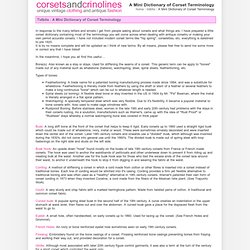
I have not included modern corset terms like "hip spring", corselettes, etc, everything is datelined to pre 1920. It is by no means complete and will be updated as I think of new terms. By all means, please feel free to send me some more or correct any that I have listed! In the meantime, I hope you all find this useful.... Also known as a stay or stays. The Corset Maker's Tools. When I first started constructing corsets, finding the right tool for the right job was a real pain.
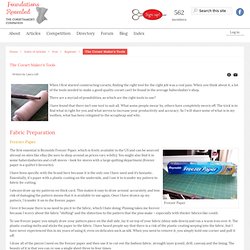
When you think about it, a lot of the tools needed to make a good quality corset can’t be found in the average haberdasher's shop. There are a myriad of possibilities, so which are the right tools to use? I have found that there isn’t one tool to suit all. What some people swear by, others have completely sworn off. The trick is to find what is right for you and what serves to increase your productivity and accuracy. Fabric Preparation. How To Make A Corset & Chemise. Easy Pattern Drafting. By Cathy Hay “Using your individual measurements, a pattern is drafted by scratch using the most exacting of standards.

It's very clinical and scientific. Everything is measured with a ruler to the greatest degree of precision possible, much like an engineering drawing, using a drafting square and a scale formula. It's extremely complicated, and everything must be checked and double-checked. There are slightly different methods you can use, but they all involve a lot of measuring and calculation. The bespoke clothing industry and the patternmaking industry make pattern drafting seem terribly complicated and mysterious, and why not?
But let's cut them a little slack. Crafting A Corset. Draft Your Own Corset Pattern. Perfectly fitting patterns at last!
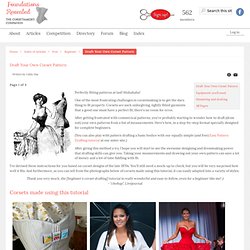
Muhahaha! One of the most frustrating challenges in corsetmaking is to get the darn thing to fit properly. Corsets are such unforgiving, tightly fitted garments that a good one must have a perfect fit; there's no room for error. After getting frustrated with commerical patterns, you're probably starting to wonder how to draft (draw out) your own patterns from a list of measurements.
Here's how, in a step-by-step format specially designed for complete beginners. (You can also play with pattern drafting a basic bodice with our equally simple (and free) Easy Pattern Drafting tutorial at our sister site.) After giving this method a try, I hope you will start to see the awesome designing and dressmaking power that drafting skills can give you. I've devised these instructions for you based on corset designs of the late 1870s.
Underbust Corset Pattern Tutorial. So here it is at last, the under bust pattern tutorial!
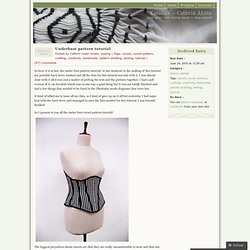
At one moment in the making of this tutorial my portable hard drive crashed and all the data for this tutorial was lost with it, I was almost done with it all it was just a matter of putting the text and the pictures together, I had a pdf version of it, on Swedish which was in one way a good thing but it was not totally finished and had a few things that needed to be fixed in the Illustrator made diagrams that were lost. It kind of killed me to loose all my data, so I kind of gave up on it all but yesterday I had some luck with the hard drive and managed to save the files needed for this tutorial. I was beyond thrilled! So I present to you all the under bust corset pattern tutorial! The biggest prejudices about corsets are that they are really uncomfortable to wear and that one cannot breath properly in them, this of course is all wrong. The measurements needed: (or were you want the bottom part of the corset to be) 1. 2. 3. 4. 5. 6. How I Sew Corsets.
Jacci Jaye's Corset Pattern #1. Rating 17 votes Buy or download pattern to rate Difficulty Intermediate Size 4/6 See Sizing Chart Type help. Reconstructing A 1910's Era Corset. For the past few years, I’ve been searching for a good pattern for a 1910’s corset, but I discovered that the number of commercial patterns and pattern diagrams from books for this type of corset is surprisingly limited.
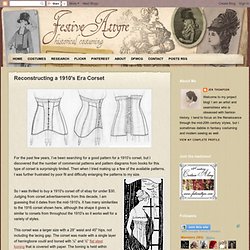
Then when I tried making up a few of the available patterns, I was further frustrated by poor fit and difficulty enlarging the patterns to my size. So I was thrilled to buy a 1910's corset off of ebay for under $30. Judging from corset advertisements from this decade, I am guessing that it dates from the mid-1910's. It has many similarities to the 1916 corset shown here, although the shape it gives is similar to corsets from throughout the 1910's so it works well for a variety of styles.
This corset was a larger size with a 29” waist and 45" hips, not including the lacing gap. The construction of this corset was very streamlined with only five pieces and no gores or bias-cut seam-lines. Enlarging the pattern Size alterations. Foundations Revealed. Introduction In this article we are going to look at a simple method for how to make a corset, one that is ideal for beginners.
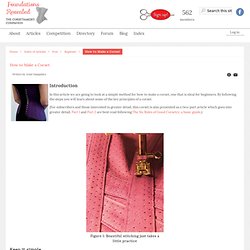
By following the steps you will learn about some of the key principles of a corset. (For subscribers and those interested in greater detail, this corset is also presented as a two-part article which goes into greater detail. Part 1 and Part 2 are best read following The Six Rules of Good Corsetry: a basic guide.) Figure 1: Beautiful stitching just takes a little practice. Perfect Boning Channels. Do you struggle to stitch straight boning channels?

Do your stitch lines end up taking unexpected detours? Lots of people have asked how to get perfectly straight and even boning channels and it’s something I struggled with for a long time. But through trial and a lot of error I have come up with a few tips and tricks that help me tame unruly stitching. I should point out that while I am confident that these techniques will help those of you who are having some problems, you won’t see the full benefit unless you practise. I never found a way round the old adage of “practise, practise, practise”.
One of the things that helped me was to draw squiggly lines on a piece of coutil, trace over them with machine stitching, and then stitch beside them again in an attempt to create a swirly boning channel. Top Tips As I mentioned before, practice. Boning Channel Choices What you use to make your boning channels is as important as how you stitch them. Planning Out Boning Channels. After the publication of my article discussing the stitching of boning channels, some questions arose as to the positioning of boning channels and some misconceptions as to the reasons for boning a corset.
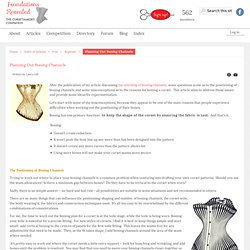
This article aims to address those issues and provide some ideas for experimentation. Let’s start with some of the misconceptions, because they appear to be one of the main reasons that people experience difficulties when working out the positioning of their bones. Boning has one primary function: to keep the shape of the corset by ensuring the fabric is taut.
How To Bind An Inverted Corner (Or V-Neck) With Bias Tape – Learning Sewing. Victorian Corset & Corsetry.